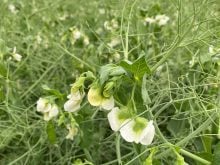The American government is getting into subsidized livestock price insurance for the first time.
In 2002 Iowa pig producers will be able to insure future sales prices and gross margins by using privately run programs subsidized by the United States Department of Agriculture.
But U.S. government officials say they don’t think the new programs will boost production.
A $10 million US limit on government subsidies and realistic premiums of about $5 per pig will prevent farmers from producing pigs the market doesn’t want, said Nelson Maurice, senior underwriter for the USDA’s Risk Management Agency.
Read Also

Crop quality looks good this year across Prairies
Crop quality looks real good this year, with the exception of durum.
His agency doesn’t want to recreate the “shackle space” situation of 1998, where prices crashed after production went beyond what packers could kill and store.
“If we put in an insurance program that’s too rich, or too heavily subsidized, there’s a danger that you’ll have an adverse impact on prices.”
Private companies will run the insurance programs and take on the risk. The government money will pay mainly for administration.
Two programs are being offered:
- The Livestock Risk Protection program will protect farmers from hog price drops. Farmers can select an available price on any day and insure 70 to 95 percent of that price for delivery of hogs at 90, 120, 150 or 180 days. Producers can insure up to 32,000 animals a year.
- The Livestock Gross Margin program insures a margin for pig producers by setting a minimum spread between the price of swine feed and the sale price of the finished pig. Farmers can be covered from 85 to 100 percent of the value of their pigs.
Both programs will be launched in April 2002.
Risk management tools already exist for livestock producers. Futures and options contracts can guarantee future prices of both feedgrains and livestock sales.
But Maurice said small farmers often aren’t able to take advantage of livestock contracts because they are denominated in far larger quantities than the actual commodities they can produce or need to buy.
And futures and options intimidate some producers, even though they need the coverage.
“A lot of farmers don’t use them because they’re uncomfortable going into the derivatives market.”
Bankers also often don’t like their farmer-borrowers to use derivatives because they open the door to speculation or margin calls.
With these insurance programs, pig producers will be able to buy coverage that fits their needs.
“What the insurance does is customizes the risk management so it matches. These programs have ‘farmer friendly’ wrapped around them.”
If the programs work, similar ones could be established in other livestock industries, but the USDA has no plans yet to establish any, Maurice said.
Rex Runyon of the American Feed Industry Association said he has already talked to a Canadian pork industry group that is wondering about setting up a similar program.















